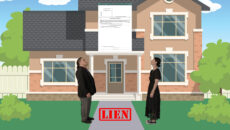Facts: An owner’s parcel of land was subject to a recorded easement benefitting an adjacent parcel as an appurtenant right for ingress and egress, and “public road purposes” to allow the neighbor access from their adjacent parcel to a public road. The neighbor later constructed a multi-family project on the adjacent parcel. Utilities and roadway improvements were constructed in the easement area for use by the occupants of the project.
Claim: The property owner sought compensation from the neighbor for loss of use and enjoyment of the owner’s property, claiming the use to which the neighbor put the easement violated the easement restrictions since the easement was limited to providing the neighbor access from their property to the public road, and did not grant the right to increase the burden on the easement by constructing improvements or allowing use by the occupants of the project.
Counter claim: The neighbor claimed the use and improvements on the owner’s parcel complied with the easement since the easement was stated to be for public road purposes, which creates a public right-of-way over the easement and permits use by occupants of the multifamily units and the construction of any utilities and roadway that accompany development of the project.
Holding: A California court of appeals held the use and improvements made by the neighbor within the location of the easement held by the neighbor violated the easement restrictions since the use of the easement was limited to a right of ingress and egress for public road purposes solely by the neighbor, and did not expand the right of the neighbor to further burden the easement by constructing utilities, a road and extending use to the occupants of the project constructed on the adjacent parcel. [Schmidt v. Bank of America, N.A., et al (February 21, 2014) _CA4th_]
Editor’s note – A neighbor’s use of an easement is limited to the intent of the easement when it was created. Here, the deed creating the easement included the phrase “for public road purposes” which functioned as a limitation on the right of ingress and egress reserved in the grant and implied use solely by the property owner. Any use that exceeds the limits of that purpose, such as the construction of utilities in the easement area or use by the occupants of the project constructed on the neighboring property (condominium owners), is an additional onus placed on the property burdened by the easement, in violation of the easement rights and restrictions.













